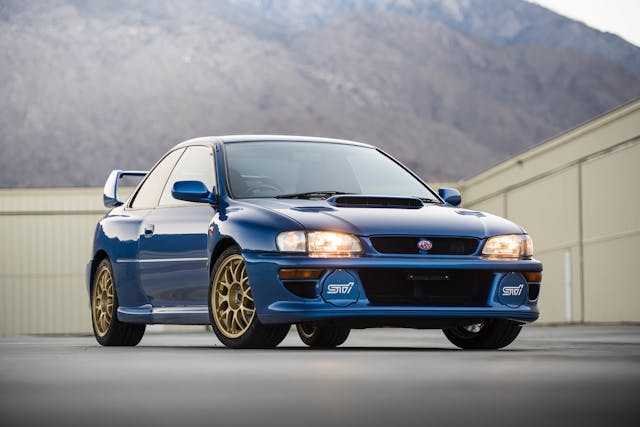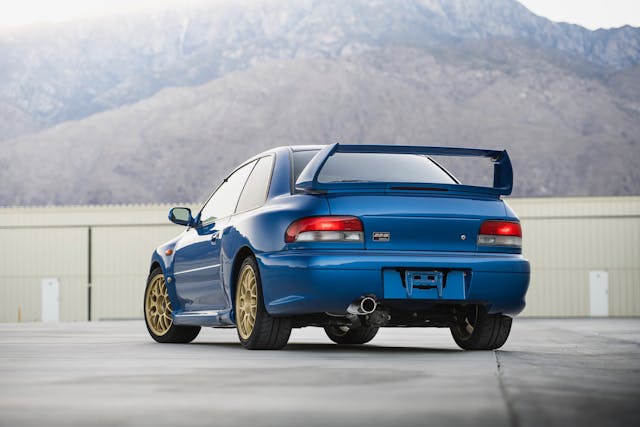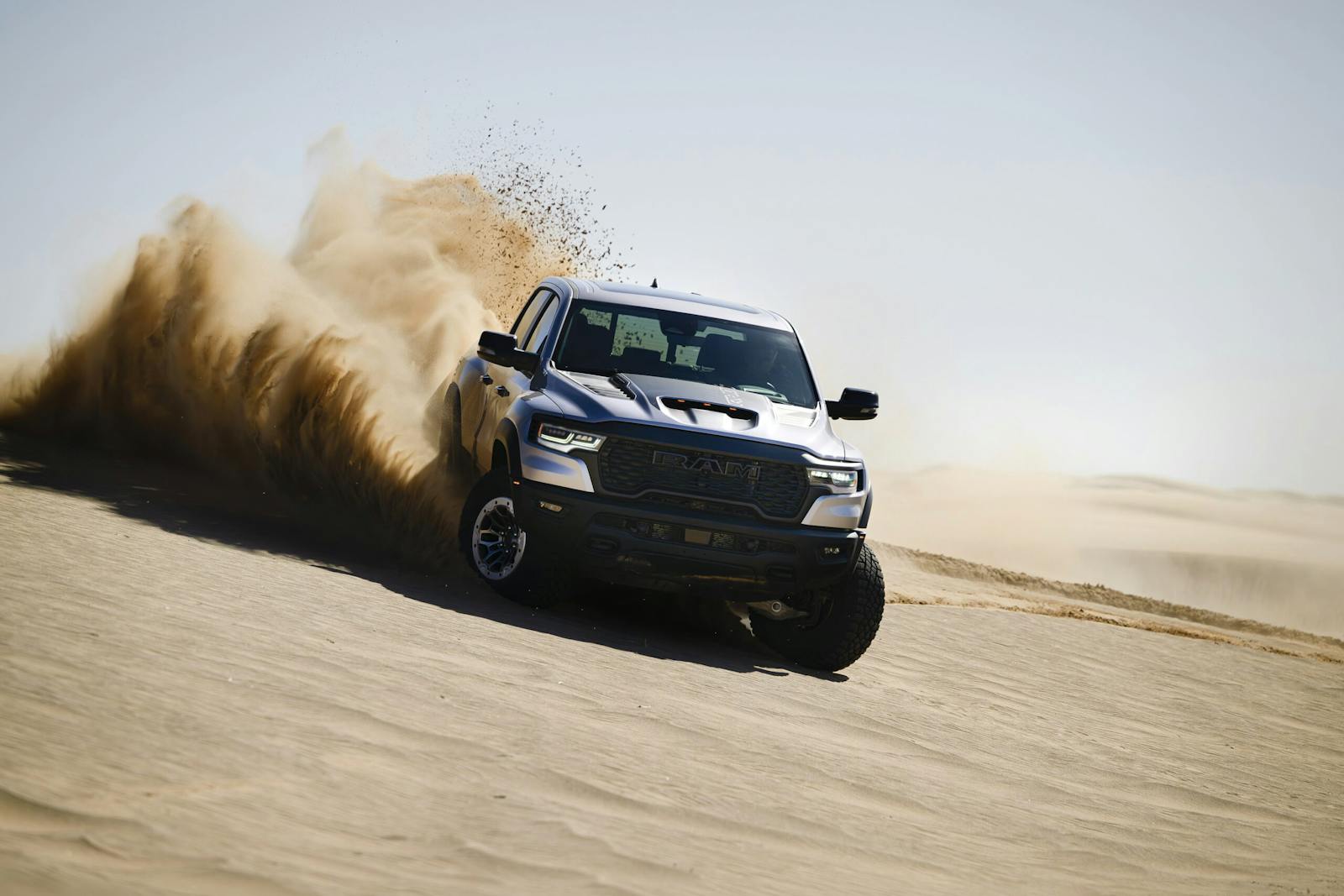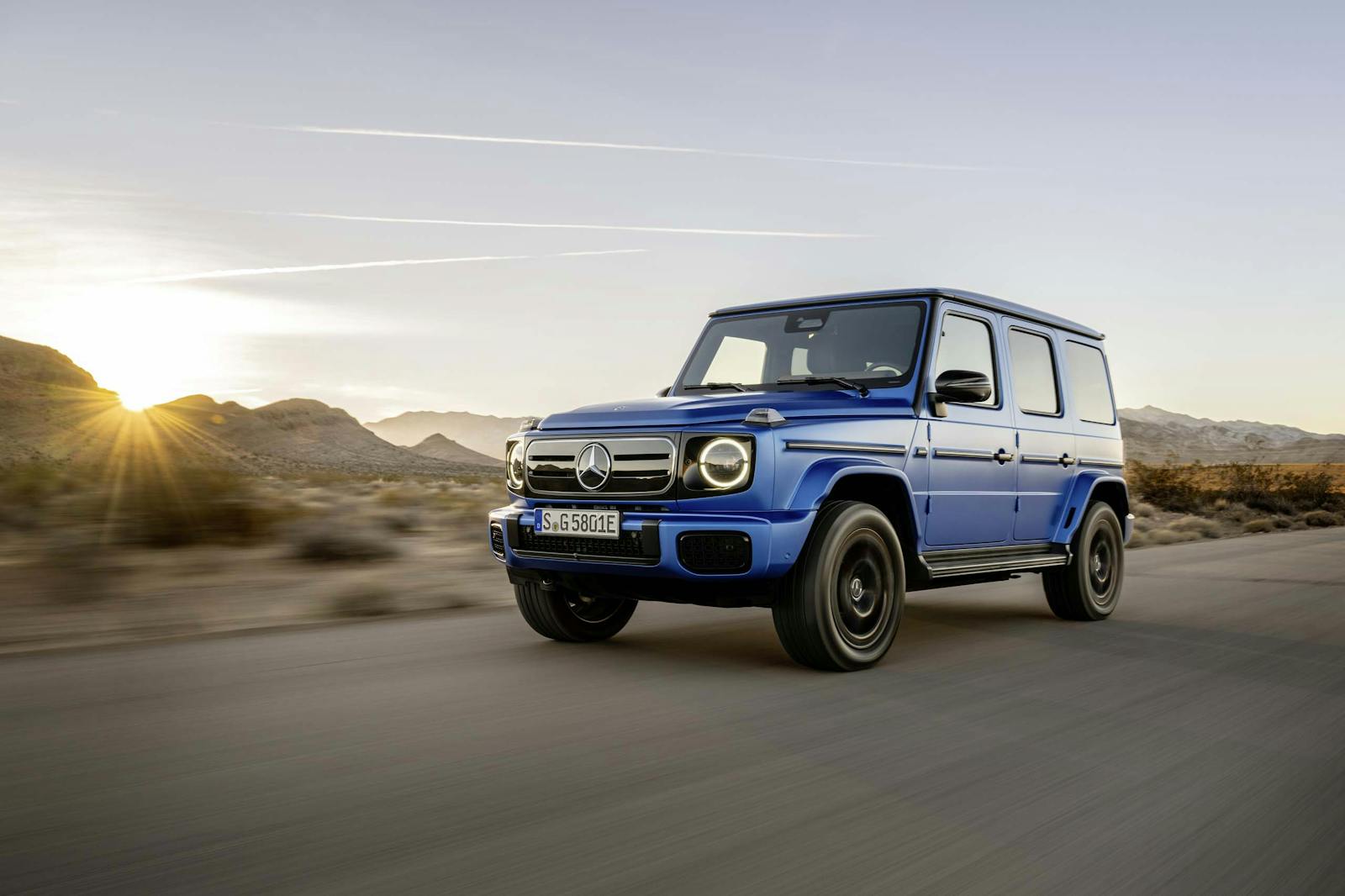Stupendously clean Subaru STi 22B cracks $300,000 in stunning BaT result (UPDATED)

JDM fans all across the country have been waiting for it, and it’s finally here: The first 1998 Subaru 22B STi offered at public auction in the U.S. just posted on Bring A Trailer.
(UPDATE 4/19/21): Called it! Since we first ran this story on April 7, 2021, the 22B in question sold for $317,555 after fees—surpassing even our bullish predictions. The last three digits of the sale price, 555, are significant to the 22B; British tobacco company State Express 555 was Subaru’s main sponsor in the World Rally Championship at the time. Bidders at $66,666 and $88,888 didn’t seem to get the reference. More details and post-analysis below.)
For those of you wondering why anyone would freak out over a relatively mild-looking Japanese compact, this isn’t just any Subaru… It’s THE Subaru. Built to honor Subaru’s 40th anniversary as well as its third consecutive World Rally Championship from 1995–97, this high-powered, all-out rally machine showcased the tuning prowess and ambition of the brand’s in-house performance arm, STi. Though Subaru claimed 280 hp from the 2.2-liter turbo flat-four, its widely accepted that this was an understatement and the real figure was closer to 300. On top of that, 22B owners enjoyed super-stiff Bilstein shocks, a twin-plated metal and ceramic clutch, and a comprehensive aero kit.
The limited-run 22B was such a hit both in real life and in the virtual world of Gran Turismo that its success encouraged Subaru to bring the Impreza WRX STI to the U.S. for the first time, starting in 2004. If you’ve ever wondered why the most potent Subarus are always painted World Rally blue and wearing gold BBS wheels, enduring adoration of the 22B and its WRC rally roots is a big reason why.
Many of us didn’t think we’d see a 22B at a Stateside auction before March 2023, when they are scheduled to become eligible for import under the federal 25-year rule. There is a sort of loophole, however. This 22B, showing roughly 25,000 miles (40,000 km) is legally in the U.S. under the 2017 Show or Display law which allows vehicles of historical or technological significance with production numbers under 500 to bypass federalization—as long as they are not driven more than 2500 miles per year.
According to the car’s seller, who spoke to Hagerty by phone, importing the car under Show or Display was surprisingly straightforward. The 22B is already on the approved list, so he only needed to fill out an application. Shipping during COVID-19 quarantine was the only pain point.
Given the relative ease of import, why did it take this long for a 22B to hit auction on our shores? For one, the 22B is incredibly rare. A total of only 424 Subaru 22Bs were produced, all in 1998—400 for the Japanese market (complete with a number plate on the center console), an additional 21 for Australia and the U.K. (no number plates), and three prototypes (with number plates reading “000/400”). In fact, according to a VIN search of our Maritime Shipping Records, only two other Subaru 22Bs have been shipped to the U.S. since they became legal under Show or Display. (This record does not account for examples flown here or shipped to Canada, then driven over the border.) On top of that, the 22B is so highly sought after that any seller would have no problem finding a line of private-market buyers.

While Subaru sent the American market the Impreza 2.5 RS in the late 1990s, it was little more than a watered-down version of the WRX. With a driver-adjustable electronically-locking center differential and intercooler water sprayer, the 22B is as close as it gets to a WRC race car for the road. A dyno sheet posted in the listing shows 241 horsepower at the wheels—more than adequate for a 2800-pound car. In classic Subaru style, power is sent to all four wheels through a close-ratio five-speed transmission.
During his ownership, the seller was most impressed with the driving dynamics of the 22B, particularly the super-quick steering. For an all-wheel-drive car, he notes, the 22B feels very light and nimble. The engine delivers power all the way to 8000 rpm, with no drop-off. As with many Japanese cars from the era, the build quality is impeccable, and how the interior materials have held up after 20+ years is rattle-free evidence of that. If you’re wondering why he’s getting rid of it if he loves it so much, the seller has imported a second 22B that he plans on keeping.

This Subaru 22B STi offered on Bring a Trailer is #156 of the 400 Japanese market cars. It’s rare to see a 23-year-old car in pristine condition, but the situation is actually quite common for the 22B. People knew this car was a big deal when it was new. Subaru reportedly sold out of all 400 JDM 22Bs in 30 minutes, and most of the owners went on to meticulously care for them.
The most recent Subaru 22B sold at public auction was also in excellent condition and will be a good benchmark for this sale. In July 2020, 22B #326 sold at Silverstone Auctions for a staggering £130,500 ($172,000 after buyers premium and VAT). The three-owner example with only 30,000 miles was 78 percent higher than 22B #307 that sold at Silverstone Auctions in 2016 for £73,125 (roughly $100,000 at the time).
A 78 percent increase in only four years isn’t surprising to anyone who’s been watching the Japanese collector market. Between the two previous 22B sales, the #1-condition (Concours) value for a 1997 Toyota Supra Turbo increased by 80 percent—from $77,500 to $139,000—while the 1996 Mazda RX-7 increased a whopping 161 percent, from $24,700 to $64,400. In that same time period, the average #2-condition (Excellent) value for a 2004–2005 Subaru WRX STi “Blobeye”, the first STi sold in America, increased 54 percent from $21,750 to $33,300. In the nine months since the $172,000 22B sale in July 2020, Blobeye values increased another 11 percent to $37,050 on average.
Back in July, I predicted the “first 22B to be sold in America will break the $200,000 barrier.” I’m going to take this chance to revise the prediction, but only to make it bolder. The first 22B to be sold in America, this car, has the potential to break $250,000. Three hundred grand isn’t impossible. Japanese cars from the 1990s sell strongly on Bring a Trailer. Just last year, a low-mile 2000 Honda Civic Si sold for an absurd $52,500.
The 22B is off to a good start. Within the first day it was clear this Subaru 22B would at least match the 2020 Silverstone $172,000 sale. With 12 days left as of this writing, bidding on this “Premium” listing sits at a cool $155,555. This car is incredibly clean and well-documented, and near-perfect examples like this actually benefit from BaT’s ruthless commenters. The more the car holds up to scrutiny, the better it looks. When people start to argue over the correct color of hood bolts, you know it’s because there’s little else to nit-pick. (Remember, that was very much the case with the 1971 Datsun 240Z that sold for $310,000.) This will be an exciting two weeks.
Post-sale analysis
$317,555 for a Subaru might sound crazy, but the 22B has huge future investment potential.
Let’s compare the 22B to another four-cylinder factory wide-body coupe from a decade earlier. Currently, the average #2-condition (Excellent) value for a 1989 BMW M3 is north of $100,000. Most agree the value is well deserved but, less than a decade ago, the E30 M3 was a sub-$20,000 car as of 2012. The E30 M3 is a favorite among Gen-X, a demographic that accounts for nearly half of E30 insurance quotes from Hagerty. As Gen-X aged into their car collecting years, E30 values rose. Since January 2015, when the youngest members of Gen-X were 35, the average #2 value of an E30 M3 increased 132 percent from $44,000 to its current value of $102,000.
Millennials are now hitting the car collecting point in their lives. Sporty Subarus are some of their favorites, and this demographic currently accounts for 63 percent of insurance quotes for the 2004–2005 Subaru Impreza WRX STI (Blobeye). As with most things Millennials hope to buy in the future, older generations are speculating. Once the 22B is fully legal for import in 2023 under the 25-year rule, values are likely to skyrocket.
We saw this happen with the Porsche 959. In September 2010, right before any 959 became fully legal, a #2-condition Porsche 959 Sport was worth $361,000. By January 2014, when all model years were fully legal, values jumped to $690,000: a 91 percent increase. A year later, the average #2 value increased another 29 percent to $890,000.
It’s very likely that this big 22B sale will bring more examples to market. In a couple years, we could see a 22B break half-a-million. Time will tell …

